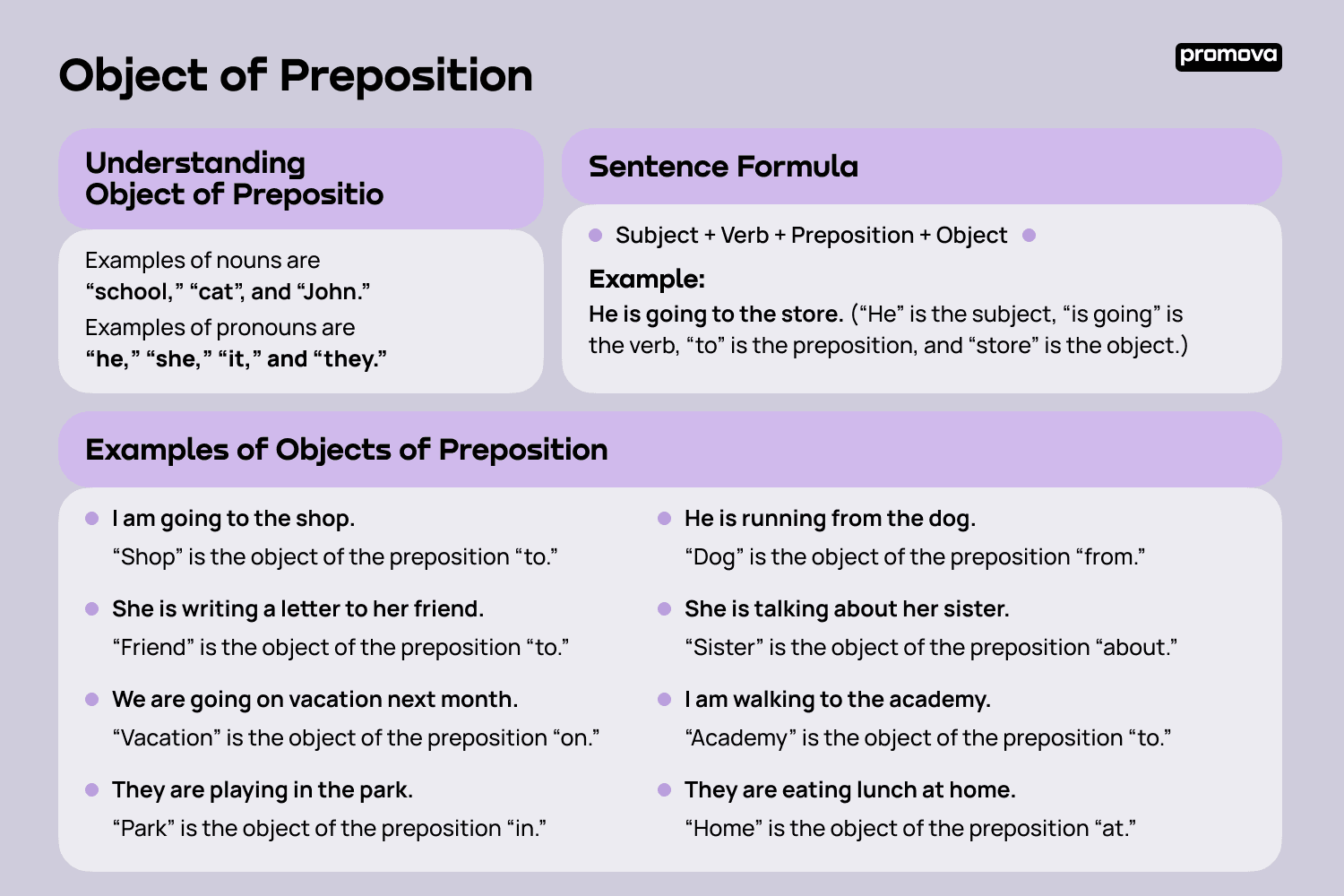Object of Preposition
Contents
Prepositions have the power to completely change the meaning of a sentence. What new English learners often struggle with is understanding how objects of preposition work. This reference will help you understand the object of preposition and its role in grammar. Let's get started!
What is an Object of a Preposition?
Objects of a preposition are nouns or pronouns that follow a preposition in a sentence. It is the thing or person that the preposition is related to. For example, in the sentence “I am going to the store,” the word “store” is the object of the preposition “to.”

Understanding Object of Preposition
Objects of prepositions can be either nouns or pronouns. Nouns are words that we use to talk about people, places, or things, while pronouns are words that replace nouns. Examples of nouns are “school,” “cat”, and “John.” Examples of pronouns are “he,” “she,” “it,” and “they.”
Objects of prepositions are always located after the preposition in a sentence. For example, in the sentence “I am going to the store,” the word “store” is following the preposition “to.” This is the pattern that will always be followed when using objects of prepositions.
Sentence Formula
Here is the formula for creating sentences with objects of prepositions:
Subject + Verb + Preposition + Object
For example, here is a sentence using the formula:
He is going to the store. (“He” is the subject, “is going” is the verb, “to” is the preposition, and “store” is the object.)
As you can see, the formula is simple and easy to remember. Following it will help ensure that you are using objects of prepositions correctly in your sentences.
8
Rules of the Object of Preposition
Now that you understand what an object of a preposition is let's explore the rules of using it.
- Objects of prepositions must always be nouns or pronouns. This means that you cannot use other parts of speech, such as verbs, adverbs, or adjectives, as objects of prepositions. For example, you could not say, “I am going to quickly” because “quickly” is an adverb.
- Objects of prepositions must always be located after the preposition in a sentence. This means that you cannot use other parts of speech, such as verbs, adverbs, or adjectives, as objects of prepositions. For example, you could not say, “I am going quickly to” because “quickly” is an adverb.
- Objects of prepositions must always refer to a person, place, or thing. This means that you cannot use abstract concepts, such as “love” or “happiness,” as objects of prepositions. For example, you could not say, “I am going to love” because “love” is an abstract concept.
These are the three main rules that you should keep in mind when using objects of prepositions. Following these rules will help you easily identify them in any sentence!
Examples of Objects of Preposition
Now that you understand the rules for using objects of prepositions, let’s take a look at 10 examples:
- I am going to the shop. (“Shop” is the object of the preposition “to.”)
- She is writing a letter to her friend. (“Friend” is the object of the preposition “to.”)
- We are going on vacation next month. (“Vacation” is the object of the preposition “on.”)
- They are playing in the park. (“Park” is the object of the preposition “in.”)
- He is running from the dog. (“Dog” is the object of the preposition “from.”)
- She is talking about her sister. (“Sister” is the object of the preposition “about.”)
- I am walking to the academy. (“Academy” is the object of the preposition “to.”)
- They are eating lunch at home. (“Home” is the object of the preposition “at.”)
Objects of prepositions give sentences more clarity and meaning. Without objects of prepositions, sentences would be incomplete and lack context. The role of objects of preposition in English grammar is that of adding clarity to your language.
Summary
Objects of prepositions are easy to identify once you understand the rules and sentence formula. Keep these rules and formula in mind when writing and speaking, so that you can easily find them in sentences and never make mistakes in the future.
Check out more handy learning resources below!
Comments